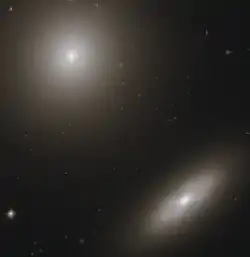NGC 1375
NGC 1375 is barred lenticular galaxy in constellation Fornax discovered by John Herschel on November 29, 1837. It is a member of Fornax Cluster.
| NGC 1375 | |
|---|---|
 Hubble Space Telescope image of NGC 1375 (down) and NGC 1374 (up) | |
| Observation data (J2000 epoch) | |
| Constellation | Fornax |
| Right ascension | 03h 35.16m [1] |
| Declination | −35° 13′[1] |
| Redshift | 643 km/s |
| Distance | 10.4 megaparsecs (34 Mly) |
| Apparent magnitude (V) | 12.2[1] |
| Characteristics | |
| Type | SB0 pec[1] |
| Apparent size (V) | 2.3′ × 0.9′[1] (23 000 light-years in diameter) |
| Notable features | Boxy-shaped bulge |
Distance and diameter estimates
It is at the estimated distance of 34 million light years. This distance is calculated by its estimate of recession velocity, the lowest one in entire Fornax Cluster, about 643 km/s. This led to uncertainites to its membership of Fornax Cluster and it also means it is uncertain form a pair with another nearby galaxy on the night sky, NGC 1374. NGC 1375 is a member of the NGC 1386 Group, which also includes NGC 1386, NGC 1389 and NGC 1396., galaxies with similar uncertanities in distance.[2] Its position on the night sky is near the center of cluster and central galaxy NGC 1399, while closest galaxy after NGC 1374, outside the pair, is NGC 1373. NGC 1375's size on night sky is 2.3' x 0.9′ which with galaxy's distance gives diameter of 23,000 light-years.
Classification
NGC 1375 is an early-type galaxy with a Hubble classification of SB0 pec, indicating it is a barred lenticular galaxy.
Despite their name, early-type galaxies are much older than spiral galaxies, and mostly comprise old, red-colored stars. Very little star formation occurs in these galaxies; the lack of star formation in elliptical galaxies appears to start at the center and then slowly propagates outward.[3] This is an early-type lenticular galaxy, with similar nature as early-type ellipticals.
Boxy-shaped bulge
This galaxy contains a boxy-shaped bulge. It is one of the few lenticular galaxies containing it, one of the other galaxies is NGC 1175. Boxy-shaped bulges are found in mostly edgewise galaxies to date. Origin of this bulge is unknown.
However, recent studies show they are not possible only for edge-on galaxy but for galaxies with inclination less than 70°, with type S0 and Sb, like NGC 1532, also in Fornax Cluster. This bulges are found in other galaxies, with much less inclination. Examples for this are barred spiral galaxies NGC 3049 and IC 676.[4]
References
- Dunlop, Storm (2005). Atlas of the Night Sky. Collins. ISBN 978-0-00-717223-8.
- "Les amas du Fourneau et de l'Eridan". atunivers.free.fr. Retrieved 2020-04-29.
- Howell, Elizabeth (2015). "Colossal Ancient Galaxies Die from the Inside Out". space.com. Retrieved 5 March 2017.
- Erwin, Peter; Debattista, Victor P. (June 2013). "Peanuts at an angle: detecting and measuring the three-dimensional structure of bars in moderately inclined galaxies". MNRAS. 431 (4): 3060–3086. Bibcode:2013MNRAS.431.3060E. doi:10.1093/mnras/stt385. ISSN 0035-8711.